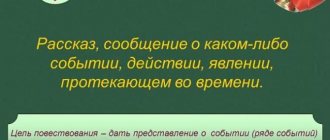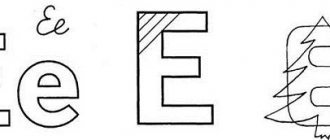Download material
so UNT / Lesson developments / Russian language lessons
Notes for the Russian language lesson “Dialectisms”, grade 6
07/13/2015 10110 604 Dubinskaya Valentina Konstantinovna Objectives: a) educational – familiarizing students with the features of dialect speech, deepening knowledge on the topic, enriching students’ vocabulary; b) developing - developing the ability to find dialect words in texts and determine their role; c) educational – instilling respect for the Russian language and its lexical norms.
Epigraph: “A local word can enrich the language if it is figurative, euphonious and understandable” (K. Paustovsky).
During the classes. I Mobilizing beginning of the lesson, message of the topic, motivation for learning. II Repetition: 1. Blitz survey: Vocabulary is... What words are called unambiguous? What words are called ambiguous? What are the names of words known to all people? What are the names of words that are not known to all people who speak Russian? 2. Work on the card “Dialectisms” (to refresh your knowledge on the topic). Dialectisms. Dialectal words (dialectisms) are words used only by residents of a certain area: beetroot (beets), sula (pike perch), kochet (rooster), dyuzhe (very); sash (belt), basque (beautiful), golitsy (mittens), kislitsa (red currant), kuren (house), gutarit (speak), etc. Words known to all people and used by everyone are called commonly used. Words that are not known to all speakers of Russian are called non-common words. These include, for example, dialect and professional words. Dialect words are words used only by residents of a particular area. The speech of the inhabitants of a particular area is called a dialect. There are three main groups of dialects in the Russian language: Northern Russian dialects (or Northern Russian dialect), Southern Russian dialects (or Southern Russian dialect), Central Russian dialects (or Central Russian dialects). ► Russian folk dialects are divided into two dialects: northern and southern. Between these dialects there are Central Russian dialects.
Note. The speech of the inhabitants of a particular area consists of commonly used and dialect words. There are fewer dialect words in each dialect than commonly used ones. The adverbs of the Russian language differ from each other, in addition, in their phonetics and grammar. For example, northerners pronounce the sound [o] in place of the letter O before the accent: [water]; this pronunciation is called okaya. Southerners pronounce the sound [a] in place of the letter O: [vada]; This pronunciation is called Akaya. Among the Central Russian dialects there are both okaya and akaya. In Siberia and the Far East there are settlements where they speak either a northern or a southern dialect. The same objects (signs, actions) are often called differently in dialects and in the literary language.
Literary words Dialect words of the Northern Russian dialect of the Southern Russian dialect rooster duck talk belt rooster duck bait gashnik kochet pitching gutar belt
Dialect words are used in works of art to convey the peculiarities of speech of residents of a certain area. Dialectal words used in works of art are called dialecticisms. Dialectisms (dialect words) are words that are used primarily by residents of one area. Thus, the word kuren (house) is used in the dialect (spoken) of the Don Cossacks: rye shoots are called winter in the north, and greens in the south; winter felted shoes in Siberia are called pima (pim - singular, im. p.), and in the European part of Russia - felt boots.. For example, the word yaruga (ravine) is used in the speech of rural residents of some places. In Novgorod and some other northern regions they say - dirty (smeared), mud (tops), dyanki (mittens). In some southern regions they say to demand (to disdain), dezha (knead), etc. The dialects still retain the names of objects of rural life and economy, flora and fauna, designations of natural phenomena, actions, qualities, etc. For example : rooster - “crow”, “song”; lightning—“thunder”; forest - “forest”, “gai”; road - “stitch”, “way”. In the dialects of the northern dialect, only dialect words are used, for example: kryga - “ice floe”, plow - “sweep”, baskoy - “beautiful”; in the dialects of the southern dialect - others, for example) kochet - “rooster”, rakhmanny - “useless”. In a literary language, the verbs of speaking: gov¬rit, say, talk - correspond to such dialect words as bayat, gutarit, balakat, kalyakat. Dialects are a special variety of the modern Russian language that develops according to its own laws. Many dialect words become commonly used and are included in synonymous groups, for example: house (commonly used), izba (Northern Russian), hut (South Russian). Dialecticisms are usually used in works of art to convey local flavor. The eastern wind blows across the native steppe. Log was covered in snow. The valleys and ravines were leveled. There are no roads or paths (M. Sholokhov). Log is a ravine. Padina is a narrow hollow. Yar is a steep, steep bank of the river. 3. Answers to questions in the form of a “brainstorming” session. What words are called dialectal? What words are called commonly used? What words are called uncommon? What words does the speech of the inhabitants of a particular area consist of? For what purpose do writers use dialectisms in fiction? III Work on the topic. 1. Studying new material from the textbook and other sources (work in groups followed by defense). Dialectisms (lexical) are words characteristic of local dialects. a) Reading a dialogue between a grandmother and her grandson and answering the question: “Why didn’t the boy understand his grandmother?” - Go, grandson, to the garden, bring beetroot for borscht. - What should I bring, grandma? - Burakov. - What is it? - Well, in our village that’s what they call beets.
The word beet is in common use, it is known to everyone who speaks Russian. The word burak is used only in the speech of residents of a certain area. This is a dialect word. Dialect words are outside the boundaries of the literary language; their use in oral and written speech instead of common literary words violates the norms of the literary language and is unacceptable. However, in the language of fiction, dialectisms are usually used for special stylistic purposes: the writer needs dialectisms mainly to create local color and speech characteristics of the characters, the author strives to give a more expressive speech characteristic of the hero, to evoke in the reader more vivid ideas about the place where the action develops . Thus, the bright and original language of M.A. Sholokhov is distinguished by the skillful use of dialectisms. Drawing in the novels “Quiet Don” and “Virgin Soil Upturned” the life of the Don Cossacks, the author uses the word kuren instead of the word hut and hut; a place in the yard fenced for livestock is called a base, a garden grove is called a levada, etc., for example: Straight orange trunks of smoke rise from the smokehouse chimneys in the morning like timber. (“Virgin Soil Upturned.”) b) Read out the dialogue with a blind boy from “Taman” by M.Yu. Lermontov. “Where is the owner?” - “No-ma.” - “How? not at all? - “Absolutely.” - “And the hostess?” - “I ran into the settlement.” — “Who will open the door for me?” - I said, kicking her. Such masters of artistic expression as Turgenev, L. Tolstoy, Nekrasov, Leskov, Melnikov-Pechersky, M. Sholokhov, F. Gladkov, A. Fadeev and others resorted to dialectisms. However, the abuse of dialect words clogs speech and obscures its meaning. But, as we said, writers, for the authenticity and persuasiveness of the created pictures of human life, use the entire wealth of lexical means of the Russian language, therefore, in the fabric of a work of art, along with general literary words, words that are used only by residents of a certain area can sometimes be included - dialectisms, for example: kochet (rooster), gutarit (talk), ravine (ravine), buchilo (deep hole with spring water). Some dialectisms, becoming commonly used, gradually enter the literary language, enriching it. Examples include the words strawberry, plowing, tentacle, clumsy, etc., which entered literary speech from local dialects. We see that there is no blank wall between the national and dialect dictionaries: many words that were dialectic words have entered the literary language. Among them are such as nonsense, owl, frail, boring, smile, take a nap, farmhand, mumble, clumsy and many others. Some of the most commonly used dialect words in works of art are included in explanatory dictionaries of the Russian literary language. With them, a litter of the region is given. (i.e. regional). Turgenev introduced the dialectic rustle into literary use. In the story “Bezhin Meadow” this word was accompanied by the author’s explanation: “as they say here in the Oryol province.” c) Read out notes from “Notes of a Hunter.” d) An example is a situation in a lesson with a girl who spoke a dialect. - Anya! Go to the board! - the teacher turns to the girl sitting at the first desk. - Write the word station. The girl hesitantly writes: station. The teacher shakes her head negatively: “Remember!” After all, I explained that it is incorrect to pronounce ulisa, sinisa,_stancia. Learn to speak and write C! The girl perked up. She briskly tapped the chalk on the board. She remembered! The word is written. But why does the teacher shake her head again? After all, Anya corrected the mistake! On the board it is written:_tstation. We understand that the girl, having corrected the mistake, immediately made another, and rather strange one. Why did this happen? Why are the errors so unusual? Why station? And where did the station come from? Well, if I had written the stanzas, then it would be clear. ~ Why, actually, is it clear? Well, of course, ts is always hard in the Russian language. But in the words fish, cheese, soap, we write s after hard ones, and after c - i. There are, however, exceptions - all the words in the phrase “The gypsy on tiptoe said “tsyts” to the chicken” - but this does not change much. Stansia is not a defect in Anya’s individual speech. That's what everyone around her says. Since childhood, Anya has not heard the sound Ts around her: after all, her grandmother, and her parents, and everyone she knew in her village spoke kurisa, yaiso. That's why she said so herself. For her, C and S always used to merge into one sound, S. As you can see, it is not easy for someone who has spoken a dialect since childhood to master the norms of a literary language. Therefore, dialects live on despite the existence of radio, newspapers, cinema, and television. 2. About V.I. Dahl’s dictionary. There are special dialect dictionaries, or dictionaries of Russian folk dialects. In Vladimir Ivanovich Dahl’s “Explanatory Dictionary of the Living Great Russian Language” there are many dialect words collected by him in different parts of Russia. For example, dialect words are names of the wind used in the north. A system of names for all the main winds has long been formed in the speech of northerners: north (northern), letnik (southern), west (western), vstok (eastern), deep-water (northwestern), shelonik (southwestern), midnight (north-western). eastern), obednik (southeastern). 3. Reading the dialogue from V. Shukshin’s story “Stubborn”. Read the dialogue from V. Shukshin’s story “Stubborn”, highlight the dialecticisms. Who do they belong to? What can replace them? For what purpose does the writer use dialectisms? Compare the speech of your interlocutors: do the remarks of one of them differ from those of the other in stylistic terms? - Why are you like this today? - asked the grandmother when they were sitting having breakfast. - Which? - Monya asked calmly and condescendingly. - Satisfied. I squinted like a cat in the sun... I had a dream, what? — I dreamed that I found ten thousand rubles in a briefcase. - Go to the devil! “The old woman grinned, paused and asked: “Well, what would you do with your name?” - What? … What about you? 4. Reading a fragment from N.A. Nekrasov’s poem “Peasant Children.” Read an excerpt from N. A. Nekrasov’s poem “Peasant Children” and find a dialect word in the speech of a peasant boy. What common word corresponds to it? - Great, lad! - “Go past!” “You’re so formidable, as I can see!” Where do the firewood come from? - From the forest, obviously. Father, do you hear him chopping? And I'll take it. 5. Game “Who is faster?” Explain the meaning of dialectisms and indicate in which works they were found. Buchilo is a deep hole with spring water. (“Notes of a Hunter” by Turgenev.) Yaruga is a ravine. (“Notes of a Hunter” by Turgenev.) Greenery – rye shoots in the south. (“Notes of a Hunter” by Turgenev.) Yar is a steep, steep river bank. (“Notes of a Hunter” by Turgenev, “Dead Souls” by Gogol.) Kuren is the house of the Don Cossacks, the same as a hut. (“Taras Bulba” by Gogol, “Virgin Soil Upturned” by Sholokhov.) Baz is a place in the yard, fenced for livestock. (“Notes of a Hunter” by Turgenev, “Virgin Soil Upturned” and “Quiet Don” by Sholokhov.) 6. Conclusions on the topic. The variety of language is due to the fact that, in addition to the generally accepted normative literary language, there is also vernacular language. It is not easy for someone who has spoken a dialect since childhood to master the norms of a literary language. Therefore, dialects live on despite the existence of radio, newspapers, cinema, and television. Dialects are a special variety of the modern Russian language that develops according to its own laws. Some features are widespread over a vast territory (for example, “Okanye”), others are found only in isolated islands. But they are always associated with a specific area and can be indicated on the map. Such an area, the territory in which this or that linguistic feature is widespread, is called an area. And the variety of the Russian language itself, containing such features, is called a territorial dialect, or patois. Russian folk dialects are numerous and varied. They are mainly common in rural areas, which is historically associated with the great isolation of life and life in the village, with the fact that there is a more stable, permanent population, and long-distance travel is rare. So, a strictly standardized literary language, processed by masters of words, and a living, unorganized element of vernacular speech; the result of the fragmentation of distant feudal times that has survived to this day - territorial dialects - and professional “languages” that are rapidly developing in the age of the scientific and technological revolution - this is what, it turns out, a complex thing is the Russian language. How many varieties, options, how many “languages” there are in it! It is not surprising that it is not so easy to know all the patterns, all the subtleties, all the complexities in the structure of this language! It is also not surprising that a lot of effort is needed to perfectly master its literary norms. 7. Creative work - writing an essay on a topic or a fragment of a literary text using dialectisms. 8. Reflection. IV Summing up the lesson. When using dialecticisms in speech, we must remember the words of K. Paustovsky: “A local word can enrich the language if it is figurative, euphonious and understandable.” V Homework - learn the meaning of terms and write an assignment on the topic of this lesson.
See the downloadable file for the full text of the material.
The page contains only a fragment of the material.



